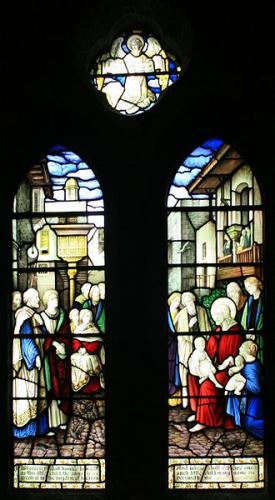Paradise Lost
 There's no avoiding the fact that sexual abuse of children is an unbelievably sordid and distressing topic-particularly when it occurs in in what should literally be a sanctuary. It's also a subject that divides, even in recollection.
There's no avoiding the fact that sexual abuse of children is an unbelievably sordid and distressing topic-particularly when it occurs in in what should literally be a sanctuary. It's also a subject that divides, even in recollection.
And its not an easy topic to write about.
Which is why Boston Globe writer Michael Paulson deserves praise for doing such an evenhanded job on a painful and controversial subject --the symbolism of creating memorials to the victims of the Catholic sex abuse scandal.
His lengthy article begins in a California memorial garden:
The new lakeside cathedral here commands attention with its oval shape and glass and steel sheath, but the small garden on its lush lawn catches the eye in a quieter way - two curving rows of privet hedges and mahogany benches embracing a 1,760-pound basalt boulder that has been broken into three pieces, then put back together.
At each entrance to the garden, a plaque spells out its purpose: "This healing garden, planned by survivors, is dedicated to those innocents sexually abused by members of the clergy. We remember, and we affirm: never again."
The garden at the Cathedral of Christ the Light is the nation's first permanent memorial to abuse victims at a Catholic cathedral, and it appears to mark a new stage in the abuse crisis, as survivors and church officials debate whether and how to commemorate the victimization of more than 10,000 youngsters by more than 4,000 priests. Two Catholic parishes, in Iowa and New Jersey, already have memorials; a religious order in Chicago agreed to build one as part of a legal settlement, but that project stalled when the order asked survivors to suggest the design
How to commemorate the scandal in the city of Boston, its "epicenter"?
Paulson found some very different opinions among California and Massachusetts survivors.
"All we wanted was our shame not being such a secret, because part of what has been so wounding has been the denial of what happened," said Terrie Light, a 57-year-old nonprofit executive who said she was abused by a Catholic priest in Hayward, Calif., when she was 7 years old. She helped design the healing garden, which opened with the cathedral in September. Light said the process of creating the garden was fraught with debate and challenges, but that she is pleased the garden is now a part of the popular cathedral tours and is shown in some of the cathedral's printed materials.
"We thought that having something permanently attached to the cathedral would make it historically real," she said.
But not all survivors in Oakland are enthusiastic.
Joey Piscitelli, a 53-year-old Martinas, Calif., contractor who said he was abused by a priest as a 13-year-old in nearby Richmond, calls the garden "meaningless" and said the diocese should instead focus more on helping victims and keeping abusers out of ministry.
"It's a small little garden, and what has it done for victims, or what is it doing for victims in the future?" he said.
He's got a lovely quote from the Archbishop who spearheaded the project-- allowing a little Catholic teaching to echo through the story.
Archbishop Allen H. Vigneron of Detroit, who was the bishop of Oakland when the cathedral was constructed, said in a telephone interview that some Catholics tried to dissuade him from allowing the garden, but that he firmly believes in its value.
"If we're going to keep kids safe in the future, it's important that we keep before us reminders of what can happen if we don't pay attention," he said.
Asked about the criticism from some who see the garden as simply a symbol, Vigneron argued that just as the Vietnam Veterans Memorial has reminded Americans of the toll of war, abuse memorials can have an effect on Catholics.
"Part of the very ecology of the Catholic Church is that symbols are actions - they're not substitutes for moral activity, but they are foundations, they are impulses that might lead to action," he said.
The writer does a nice job on a number of levels. He doesn't rely on one or two quotes from victims. Paulson talked to local victims who want a memorial and those who think the money should be spent helping those who were harmed. He visited one of the apparently few memorial gardens, and talked to diocesan officials pondering memorials in Massachusetts.
Paulson even gets the historical point of view from a scholar of memorials -- an increasingly controversial part of contemporary life.
Church officials aren't portrayed as goats--they are an organic part of the process of reflection. He honors the many layers and strong emotions associated with the topic without judgment and without condescension.
The only people he didn't interview, apparently, were those who wish the whole subject would just go away.
Picture of Jesus with children from Wikimedia Commons